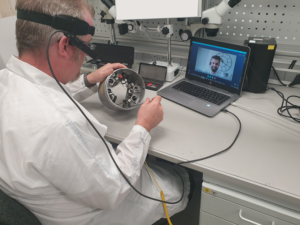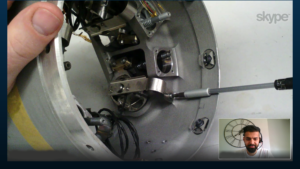Getting an engineer’s eye view from behind a keyboard
How smart glasses are connecting MBDA colleagues throughout Europe
Innovation is part of the MBDA’s values, ensuring strategic and operational advantage. The COVID crisis has meant the need to accelerate some of the innovative solutions to problems that a pan-European company faced even before coronavirus changed the world.
One such accelerated programme at MBDA is the use of smart glasses. These are a hands-free Assisted Reality solution. They are improving the ability of engineers to remotely collaborate at a moment’s notice. Whether on site, at home or in another country.
Increasing use

Initially their use was being developed by MBDA’s Customer Support and Services teams and Factory of the Future teams. However, the equipment has now been adopted by the Manufacturing teams. They are now using them to support collaborative working on programmes such as Brimstone, Land Ceptor (EMADS) and SPEAR.
Neil, part of the Factory of the Future team in MBDA says: “Using smart glasses allows operators to work completely hands free, while performing an operation or demonstrating a problem, whilst broadcasting what they can see and interacting with engineers in different or multiple locations. Engineers can show each other what they are looking at, walk around, point things out and discuss physical issues wherever they are.”
Andy, part of the Manufacturing team, adds: “With smart glasses technology our Manufacturing teams, for instance in Stevenage and Bolton, are now still supported by their colleagues in the design team who are working remotely from home or other locations.”
Advantages
Communication is not just one way. The assisted reality element of the smart glasses allows those watching the live video stream to talk, share documents and annotated images with the wearer as they work. This means the wearer doesn’t have to refer to a laptop or tablet.

Andy continues: “The glasses provide a technician’s view of the work they are undertaking, and colleagues observing can talk to them throughout what is being carried out.”
Neil adds: “There are real health and safety advantages. It means all parties can see and talk, while the wearer still has both hands available to work on. You don’t have that with a mobile phone.”
Collaboration is at the heart of how MBDA operates. Examples of this are multi-lateral programmes like Meteor and Aster/PAAMS. Or bi-lateral programmes like Storm Shadow/SCALP, Taurus, CAMM-ER and Sea Venom/ANL. Add in domestic customers across five European countries. As well as export customers and joint ventures spread out across the world. MBDA’s collaboration is truly global.
Now and in the future
Constraints, like time or cost, on not being able to meet face-to-face to discuss technical problems existed before countries went into lockdown. So the smart glasses solution that was connecting people in France with counterparts in India, is now just as convenient to connect MBDA sites across the UK and Europe.
COVID restrictions aside, this project was always going to have a future. Neil added he can see “great potential” to reducing the need to travel. He says: “Take CAMM-ER, the team working on that here in the UK can link up remotely with their counterparts in Italy and collaborate with them without having to travel”. And whilst there are “technological limitations” Neil concludes: “it’s a great tool in the current environment and one that we can build into our routine ways of working”.